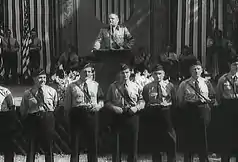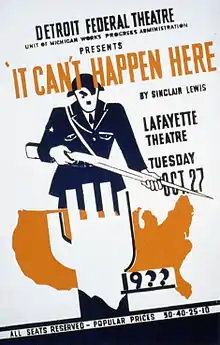Nazism in the Americas
Nazi and fascist parties and other pro-Nazi organizations were formed in the Americas during the late inter-war period, in both the United States and South America. The members of these groups reflected the sympathies of some German-Americans and German Latin-Americans towards Nazi Germany, embracing the National Socialist spirit in Europe and establishing it within the Americas. Throughout the inter-war period and the outbreak of World War II, American Nazi parties engaged in activities such as sporting Nazi propaganda, storming newspapers, spreading Nazi-sympathetic materials and infiltrating other non-political organizations.

The reaction to these parties was varied, ranging from widespread support to outright resistance, including the formation of the first anti-Nazi Jewish resistance organizations in the United States, such as the Non-Sectarian Anti-Nazi League to Champion Human Rights. [1]
Nazism continued after the end of World War II in the Americas, particularly in the United States with the influx of refugees entering the country fleeing the war. Many Nazi sympathisers entered the United States with the intention of continuing their support of Nazism even with the termination of the war. These attitudes have continued into the 21st century, with many supporters of Neo-Nazism still existing within the United States and pro-Nazi groups, who have been known to attack and harass minorities.
United States

Inter-war period
Adolf Hitler rose to power in 1933, becoming Chancellor of Germany on the 30th of January.[2] By the Spring of 1933, a new political party emerged in the United States; the Friends of New Germany. Previously, German-Americans had attempted to create pro-Nazi movements within the United States, often bearing swastikas and wearing uniforms, however these groups had little to do with Nazi Germany and lacked support from the wider German-American community in the United States.[3] In May 1933, German immigrant and member of the Nazi Party, Heinz Spanknöbel was given authority by the Deputy Führer of Germany, Rudolf Hess to form an official American branch of the Nazi Party, which would become the “Friends of New Germany” party,[3] called the 'National Socialist German Workers' Party of the U.S.A.' by the NSDAP.[2] Though the party had a strong presence in Chicago, it remained based in New York, having received support from the German consul in the city. Spanknöbel's organization was openly pro-Nazi, with organization going so far as to storming the U.S. German language newspaper New Yorker Staats-Zeitung, demanding that the paper publish Nazi-sympathetic articles. Spanknöbel's leadership was short-lived, however, as he was deported in October 1933 following revelations that he had not registered as a foreign agent.[3] Following the election of Franklin Delano Roosevelt in 1932 and his inauguration in 1933, some pro-Nazi groups did indeed plan to overthrow the American government in a coup d'état.[4][5] Some American corporations, such as overseas divisions of Eastman Kodak, made financial contributions to the new regime by continuing trade relations even after war was declared.[6]
World War II


The Friends of New Germany dissolved in the 1930s into a new party known as the Amerika-Deutscher Volksbund (German American Bund), led by Fritz Kuhn. The party would exist from 1935 until 1941, when America formally entered the Second World War. The Bund existed with the goal of a united National Socialist German America, and was antagonistic towards communists, proclaiming Communism as their main target, and also expressed anti-Semitic attitudes.[3] The Bund was inspired by the Hitler Youth and created their own youth division, where members “took German lessons, received instructions on how to salute the swastika, and learned to sing the “Horst Wessel Lied” and other Nazi songs.”[7] The Bund continued to justify and glorify Hitler and his movements in Europe during the outbreak of World War II; after Germany invaded Poland in 1939, Bund leaders released a statement demanding that America should stay neutral in the ensuing conflict, as well as expressing sympathy for Germany's war effort. The Bund reasoned that this support for the German war effort was not disloyal to the United States, as German Americans would “continue to fight for a Gentile America free of all atheistic Jewish Marxist elements.”[7] According to the North American German Bund, a fascist was one who "discovers that democracy does not work". For them George Washington was the first fascist.[8]
After many internal and leadership disputes, the Bund's executive committee agreed to disband the party, the decision coming the day after the bombing of Pearl Harbor. On December 11th, 1941, the United States formally declared war on the united Axis powers, and Bund headquarters were subsequently raided by Treasury Department agents. All records were seized and 76 Bund leaders were arrested and taken into custody.[7]
After World War II
The OSI (Office of Special Investigations) estimated that around 10,000 Nazi war criminals entered the United States from Eastern Europe after the conclusion of World War II. This number was reached based on the fact that of the 40,000 immigrants who entered the United States, at least 2.5 per cent had been persecuted in the Nazi era.[9] Most Nazi collaborators entered the United States through the 1948 and 1950 DP Acts and the Refugee Relief Act of 1953. Supporters of the DP Acts showed only a slight awareness of the possibility of Nazi war criminals entering the United States through the Acts, with most concern being placed on disallowing known Communists from entering. This shift of focus was likely due to the pressures of the Cold War in the years after World War II, with the United States focusing on countering Soviet Communism more than Nazism.[10][9]

During the 1950s, several investigations into suspected Nazi war criminals were conducted by the INS, but no official trials came from these investigations. The 1950s did not trigger a widespread discourse on the Holocaust or the possibility of Nazi collaborators living in the country, but this changed in the 1960s with the trial of Adolf Eichmann. In the 1960s, the United States began to focus on discovering Nazi war criminals remaining in the country. This came about due to several factors, including the 1962 trial of Adolf Eichmann, accusations of war criminals during Soviet war crimes trials in 1961-2 and a series of articles published by Charles R. Allen, detailing the presence of Nazi war criminals living in the United States.[9]
The 1970s saw increased public awareness of the Holocaust and Nazi war criminals, with many cases making headline news. The case of Hermine Braunsteiner-Ryan, the first Nazi war criminal to be extradited from the United States, received widespread coverage by the media, and the case triggered a drive by the INS to further locate Nazi collaborators.The New York Times at this period also took an interest in the effort, covering the search for collaborators. By the late 1970s, thousands of cases were addressed by the INS, and the U.S. government formed the OSI, dedicated specifically to locating Nazi war criminals in the United States.[9]
21st Century

Christopher Cantwell is one of important leaders of nazi-americans.[11]
South America
Inter-war period
In 1932, a national socialist party was officially created in Chile, called the National Socialist Movement of Chile (MNSCH) or ‘el nacismo.’ It was founded by Jorge Gonzalez von Marees alongside Carlos Keller Rueff, Juan de Dios Valenzuela and Gustavo Vargas Molinare. The members were referred to as Nacistas and the larger party was made up of a pyramid-structured hierarchy led by a Jefe, the greater party made up of various National Councils and the storm troops called the TNA. The party lacked a militant stand to racial matters, unlike European Nazism, as the matter of racial purity was not seen as having much importance in Chile and was deemed counterintiuitve to the national tradition. However, the MNSCH operated like many other fascist movements, with emphasis on military values, elitism, hierarchy, discipline, need for action, etc. The MNSCH also viewed the state as a form of self-preservation, and saw the need for a totalitarian, unified order, akin to European Nazism.[12]
World War II
Generally during the war, South American countries were opposed to the Axis powers and Nazism in Europe, particularly after the bombing of Pearl Harbour in 1941. Others maintained that continuing economic relations with countries on both side of the war would be beneficial. In Argentina German influence was strong due to a high number of German immigrants,[13] but in Chile there was opposition to the German community due to a failed Nazi-backed coup in 1938. The United States issued a project during the war in order to generate and spread anti-fascist propaganda across Latin America, made up of radio broadcasts and motion pictures.[14]
After World War II
After World War II officially ended, many Nazis and other fascists fled to South America through the use of ratlines. Many of these ratlines were supported by the Vatican and the Catholic church; the first movements to smuggle Nazis and fascists came in 1946 when two Argentinian bishops colluded with a French Cardinal to bring French war criminals into Argentina. Under Argentine president Juan Perón’s instructions, many European war criminals were brought into the country and given citizenship and employment.[15] One such supposed escapee was Adolf Hitler himself, with the FBI launching an investigation in the 1940s and 1950s to investigate this possible escape[16]
See also
Bibliography
- Black, Edwin (2001). IBM and the Holocaust: The Strategic Alliance between Nazi Germany and America's Most Powerful Corporation. [S.l.]: Crown Publishers. ISBN 9780914153276
- BOLAÑO, Roberto. A literatura nazista na América. São Paulo: Companhia das Letras, 2019;
- KAKUTANI, Michiko. A morte da verdade; notas sobre a mentira na era Trump. Rio de Janeiro: Intrínseca, 2018
- FINCHELSTEIN, Federico. Do fascismo ao populismo na história. São Paulo: Almedina, 2019
References
- Hawkins, Richard A. (2013), "The internal politics of the Non-Sectarian Anti-Nazi League to Champion Human Rights, 1933–1939", Management & Organizational History, 5 (2): 251–78, doi:10.1177/1744935910361642, S2CID 145170586]
- Diamond, Sander A. “The Years of Waiting: National Socialism in the United States, 1922–1933.” American Jewish Historical Quarterly, vol. 59, no. 3, 1970, pp. 256–271. JSTOR, www.jstor.org/stable/23877858.
- Jim Bredemus. "American Bund – The Failure of American Nazism: The German-American Bund's Attempt to Create an American "Fifth Column"". TRACES.Retrieved May 2nd 2019.
- The Plot to Overthrow FDR
- The McCormack-Dickstein Committee (1934-1935)
- Kodak’s Nazi Connections
- Bell, Leland V. “The Failure of Nazism in America: The German American Bund, 1936–1941.” Political Science Quarterly, vol. 85, no. 4, 1970, pp. 585–599. JSTOR, www.jstor.org/stable/2147597
- Cosgrove, Ben. "George Washington Was 'the First Fascist,' and Other American Nazi Drivel". Time. Archived from the original on 2015-09-30. Retrieved 2021-02-06.
- Schiessl, Christoph. Alleged Nazi Collaborators in the United States after World War II. Lanham: Lexington Books, 2016.
- Govan, Fiona (2012-10-15). "Fidel Castro 'recruited Nazi SS members to train troops during Cuban missile crisis'". Daily Telegraph. ISSN 0307-1235.
- O neonazi Christopher Cantwell já foi publicado por sites neoliberais do Brasil
- Etchepare, Jaime Antonio, and Hamish I. Stewart. "Nazism in Chile: A Particular Type of Fascism in South America." Journal of Contemporary History 30, no. 4 (1995): 577–605
- Leonard, Thomas M; John F. Bratzel (2007). Latin America During World War II.Rowman & Littlefield. ISBN 0742537412.
- Kornel Chang, "Muted reception: US propaganda and the construction of Mexican popular opinion during the Second World War." Diplomatic History 38.3 (2013): 569–598.
- Goñi, Uki (2003). The Real Odessa: Smuggling the Nazis to Perón’s Argentina (revised ed.). London: Granta
- “New Investigation Questions Hitler’s Suicide”. Newhistorian.com. 20 November 2015. Accessed 31 May 2018.